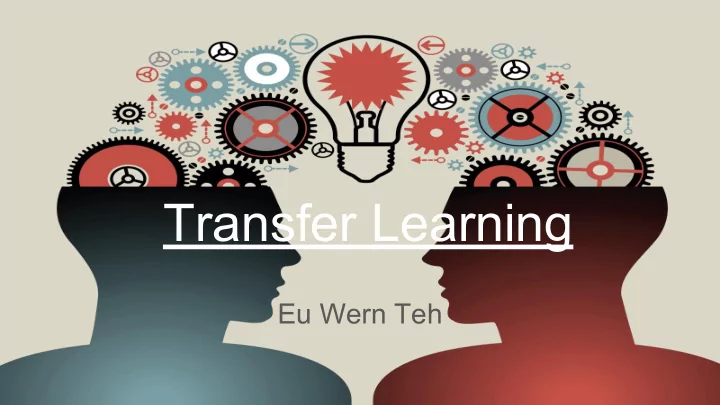

Transfer Learning Eu Wern Teh
What are we covering? ● Why transfer learning? ● Fine Tuning: how? why? Example ● Practise: ○ Ants and Bees dataset ○ Caltech 101 dataset
Why Transfer Learning? ● Speedup Training ● Improve generalization (especially: less data) ● Transfer Learning: ○ Fine Tuning ○ Domain Adaptation ■ train a model that does the same thing on different environment ● eg: object classification on high vs low resolution image ● eg: customer rating estimation on various domain (travel review vs hotel review)
Domain Adaptation ● Source and Target domain have the same labels but in a different domain ● Large number of labeled data source domain, but opposite for the target domain Amazon Webcam
Domain Adaptation Product Rating Electronics Video Games
Fine Tuning ● Most common form of transfer learning. ● Easy and Effective ResNet ImageNet Dataset
Fine Tuning ● In practise, very few people train their model from scratch (with random weight initialization) ● Fine Tuning is achieved by initializing your model with weights train on another dataset: ○ ImageNet 2012 - 1000 classes and 1 millions images (1000 images per class) ○ VGG Faces dataset - 2622 identities and 2.6 millions images (991 images per class) ● Learning rate manipulation during training ○ high vs low learning rate will affect the testing performance of your new dataset. ○ highly dependent on the size of dataset.
Why fine tuning works? ● Features or Pattern that are working for one dataset may be useful on some other dataset. A series of stack layers that extracts increasingly abstract features from the image. The higher the layers, the more abstract the features. Lines → Edges → Shapes → Object Parts → ...
Deep Network ● ResNet architectures:
Deep Network ● ResNet-18
Machine Learning Practitioner Output Component 2 Component 1 Data
Manipulate Learning Rate ● What features should we keep the most? (little to no change) what features should we adapt the most? (lots of change → adapt to dataset) ● Lines? A series of stack layers that Edges? extracts increasingly abstract features from the image. Shapes? Object Parts? The higher the layers, the Classifier? more abstract the features. Lines → Edges → Shapes → Object Parts → ...
Overfitting (Seen Data) Model A Generalization Model B (Unseen Data)
Manipulate Learning Rate ● If we have a small dataset, we would trust the lower level features from our pretrain model. (It has seen more lines, Edges, Shapes ... ) ● Lines? Edges? ● We trust it by not Shapes? changing the features too much → Object Parts? low learning rate Classifier?
Deep Network ● ResNet-18
CIFAR 10 dataset Created by: Alex Krizhevsky, 2009 60,000, 32x32 Color images. 6000 images per class 50,000 training 10,000 testing
Experiments on Fine Tuning on Cifar 10-4000 All models terminate at 100 epochs. Models Descriptions Train Acc Test Acc Model A (no fine tuning) set all lr = 1e-1 99.98% 76.34% Model B set all lr = 1e-1 99.61% 66.10% Model A (no fine tuning) set all lr = 1e-4 44.97% 41.89% Model B set all lr = 1e-4 92.04% 87.14% Model C set all features lr = 1e-4 99.68% 88.72% set class lr = 1e-1
Experiments on Fine Tuning on Cifar 10-4000 All models terminate at 100 epochs. Models Descriptions Train Acc Test Acc Model C set all features lr = 1e-4 99.68% 88.72% set class lr = 1e-1 Model D set conv1, conv2 and conv3 lr = 1e-4 99.88% 89.65% set conv4 and conv5 lr = 1e-3 set class lr = 1e-1
How to do it? opt = optim.SGD([{'params':model.base[0].parameters(), 'lr': args.lr * 1e-3}, {'params':model.base[4].parameters(), 'lr': args.lr * 1e-3}, {'params':model.base[5].parameters(), 'lr': args.lr * 1e-3}, {'params':model.base[6].parameters(), 'lr': args.lr * 1e-2}, {'params':model.base[7].parameters(), 'lr': args.lr * 1e-2}, {'params':model.fc1.parameters()}], lr=args.lr, momentum=0.9, nesterov=False, weight_decay=5e-4)
Freezing Learning Rate ● If you are setting your learning rate to zero on some layers, you should set the requires_grad attribute to False. (This allows you to save some memory and compute time). ○ for param in model.base.parameters(): param.requires_grad = False
Mean and Standard Deviation adjustment ● Feature Normalization ● you need to normalize your image with the mean and standard deviation of your pre-trained model ● If you fine-tune your network with ResNet model train on ImageNet in Pytorch model: ○ input needs to be scale from 0 to 255 to zero to one ○ the means of RGB: 0.485, 0.456, 0.406 ○ the std of RGB: 0.229, 0.224, 0.225 ○ https://pytorch.org/docs/stable/torchvision/models.html ● if you fine-tune your network with ResNet model train on ImageNet in Caffe ○ you to load your image in BGR and inputs needs to be in 0 to 255 ○ the means of BGR: 103.939, 116.779, 123.68 ○ do not need to divide by std.
Ants and Bees dataset ● Small quantity of big resolution images. ● 398 images, 2 classes, (199 images per class) ● 10% training ● 10% validation ● 80% testing ● Random Chance: 50% ● Test Accuracy (base); 60.13% ● Test Accuracy:(fine-tune) https://jupyter.co60.ca 86.71%
Caltech 101 dataset ● medium quantity of big resolution images. ● 9144 images, 102 classes, (89 images per class) ● 1% training ● 1% validation ● 98% testing ● random chance: ~1% ● Test Accuracy(base): 19.78% ● Test Accuracy(fine-tune): 38.2%
Recommend
More recommend